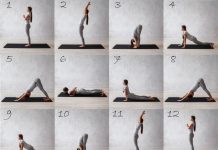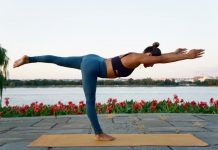Vinyasa Yoga, more commonly referred to as “Flow Yoga”, is one of the most popular forms of yoga practiced today. Not to be confused with Power Yoga, Flow Yoga is characterized by stringing various postures together, so the sequence moves in an uninterrupted flow.
The word Vinyasa itself means “variation, within parameters” in Sanskrit. Flow Yoga is deeply rooted in the belief that staying grounded or rooted is vital, and it is imperative that bodies are not being carelessly thrown about.
Characteristics of Flow Yoga
One of the benefits of Flow Yoga is that due to the various postures, it is rare that two classes are alike. Unlike Bikram Yoga, in which each class must abide by the same 26 postures in each class, Flow Yoga has no set sequence of asanas.
Flow Yoga transitions from one asana to the next through breath, without stopping. Indeed, the reason in is also popularly referred to as Flow Yoga is because the postures seamlessly flow into the other. Whereas in other practices, scubas Ashtanga, practices are held, explored, then broken out of, Flow Yoga is continuous.
Indeed, it is very important to view transitions in Flow Yoga as postures themselves. The transitions should be as seen as an extension of, not a respite from the posture itself.
Flow Yoga places a great emphasis on the present moment. When one practices an asana, they remain there briefly, then transition into another pose. It also must be noted that even when still within the asana, that there is still a movement that exists. The beating of the heart and inhale and exhale of the breath for example, are parts of the body still in “flow”.
The Importance of Breath in Flow Yoga
Flow Yoga places a deep emphasis on breath. It believes that the breath is a life force. It also believes that that breath is responsible for every action and intention we put out into the universe.
Breath is vital when practicing Flow Yoga, because it is the initiator of the movement. In fact, you may hear Flow Yoga noted to as a “breath-synchronized” yoga.
Ujjayi Breath, also referred to as “ocean breath”, or “cobra breathing” is the technique of breathing used win conjunction Flow Yoga. In this technique, the inhale and exhale occurs in a consistent rhythm in and out of the nose. This type of breathing promotes relaxation and balance. It also is important in that it contains the pronoun, or life force within the body, rather then allowing it to escape from the body.
It is easy to see where Flow Yoga is also seen as a meditation class in motion. Emphasizing harmony, balance and ease, we are much more open to ourselves, our surroundings and what affects us.
Benefits of Flow Yoga
One of the many benefits of Flow Yoga is it aids in the development of a much more balanced, harmonious body. Also, due to the ever-changing asanas, the likelihood of physical injuries is much less.
In addition, also not as rigorous as Power Yoga, Flow Yoga generates warmth throughout the body and adds a cardio workout of sorts, generally not found in most other practices. Flow Yoga does not have to have maintain the same level of intensity throughout, it can move from high levels of intensity to much lower. Regardless of the intensity, because of the continuous movement, Flow Yoga is a great way to build up endurance, straight, and flexibility. In fact, you are more likely to reap the benefits if done at a slower pace.
Flow Yoga is a excellent practice in that is hits nearly all of the groups of asanas- from stagnant postures, to forward beds, to back bends, to sitting postures. Because asanas of different groups are visited in every class, there is an added benefit in that greater time and depth and knowledge can be applied to each pose, as it is continually visited.
Flow Yoga Asanas
In Flow Yoga, classes begin which a Child’s Pose, to signify the beginning, and end with Corpse Pose, to signify the cycle or completion of life. And although as previously mentioned, classes will continually vary, there are poses which will continually be revisited. Some staple asanas in Flow Yoga are:
Standing Vinyasa Flow
A surefire way to fire up the flow of energy throughout the body, especially the waist and legs.
Sun Salutations
This engages the entire body, at all levels, from the mountain, to warrior, to downward dogs, to cobras to chaturangas. Breath is vital here to maintain the flow, and it is usually introduced in the beginning of classes.
Balances and Twists
Extended holds and deep twists are vital in a Flow practice. Standing splits and seated twists are also excellent are developing endurance and flexibility, while twists aid in digestion and relieve and release lower back tension.
47 Most Famous Motivational Quotes of All-Time
49 Greatest Love Quotes
37 Inspirational Quotes that Will Change Your Life






























